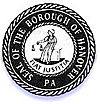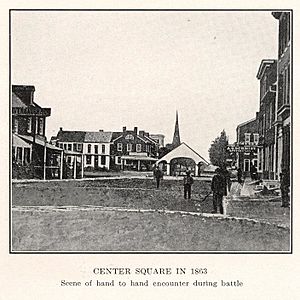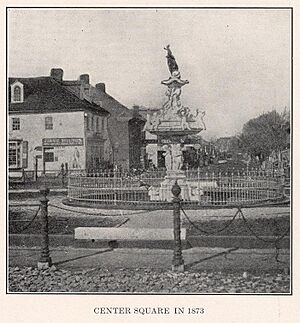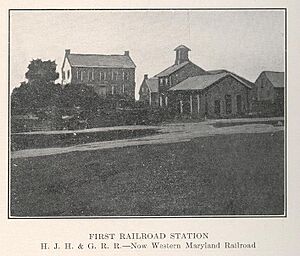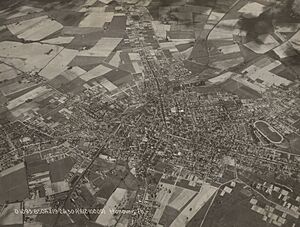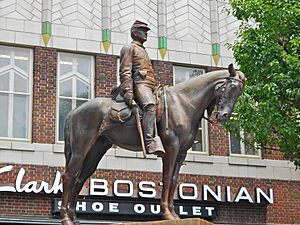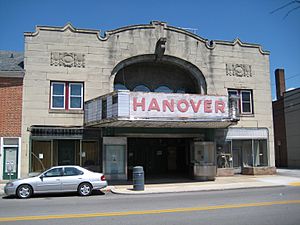Hanover, Pennsylvania facts for kids
Quick facts for kids
Hanover, Pennsylvania
|
|||
|---|---|---|---|
|
Borough
|
|||
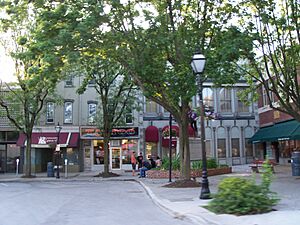
|
|||
|
|||
| Nicknames:
Black Rose Community, Snack Capital of the World, Rogue's Roost
|
|||
| Motto(s):
Fiat Justitia
(Latin: Let Justice Be Done) |
|||
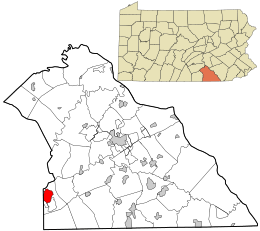
Location in York County and the U.S. state of Pennsylvania.
|
|||
| Country | United States | ||
| State | Pennsylvania | ||
| County | York | ||
| Founded | 1763 | ||
| Incorporated | March 4, 1815 | ||
| Founded by | Richard McAllister | ||
| Named for | Hanover, Germany | ||
| Government | |||
| • Type | Mayor-Council | ||
| Area | |||
| • Total | 3.70 sq mi (9.57 km2) | ||
| • Land | 3.70 sq mi (9.57 km2) | ||
| • Water | 0.00 sq mi (0.00 km2) | ||
| Elevation | 614 ft (187 m) | ||
| Population
(2020)
|
|||
| • Total | 16,429 | ||
| • Density | 4,445.08/sq mi (1,716.10/km2) | ||
| Demonym(s) | Hanoverians | ||
| Time zone | UTC-5 (Eastern) | ||
| • Summer (DST) | UTC-4 (Eastern) | ||
| ZIP Code |
17331, 17332, 17333, 17335
|
||
| Area code | 717 and 223 | ||
| FIPS code | 42-32448 | ||
| GNIS feature ID | 1215748 | ||
Hanover is a town in York County, Pennsylvania, United States. About 16,429 people lived there in 2020. It is located about 19 miles (31 km) southwest of York. It is also about 54 miles (87 km) north of Baltimore, Maryland.
Hanover is in a good farming area. The town is named after the city of Hanover in Germany. It is an important town in the York–Hanover metropolitan area.
Hanover was the place of the last battle between the Union and Confederate armies before the big Battle of Gettysburg. This happened during the American Civil War. Today, Hanover is known as the "Snack Food Capital of the World." This is because many food companies started there in the 1900s. Famous companies like Utz Brands and Snyder's of Hanover are based here.
Contents
History of Hanover
In 1727, John Digges got a large piece of land where Hanover is now. He was an Irish nobleman from Maryland. This area was called Digges Choice. In 1730, a group of Catholics started a settlement there. It became known as the Conewego Settlement.
Settlers from both Maryland and Pennsylvania moved into the area in the 1730s. At this time, Maryland and Pennsylvania did not agree on their border. The area where Hanover is now was claimed by both states. This caused many arguments about who owned the land.
The arguments lasted from the 1730s until 1760. To solve the problem, Maryland and Pennsylvania hired two British experts. They were Charles Mason and Jeremiah Dixon. They surveyed the land between 1763 and 1767. This survey created the Mason–Dixon Line. This line finally ended the long-standing border disputes.
In 1745, a man named Richard McAllister bought the land where Hanover was built. He was from Scotland and Ireland. McAllister was a Presbyterian who had moved from the Cumberland Valley. At that time, Hanover was a thick forest of hickory, walnut, and oak trees.
McAllister built a log house and opened a store and a tavern. This was at what is now the corner of Baltimore and Middle streets. In 1763, McAllister divided his land into smaller parts. This is how he founded the town of Hanover. German settlers called the town "Hickory Town." This was because of the many hickory trees.
The name Hanover was suggested by Michael Tanner. He was one of the people who helped create York County in 1749. Tanner owned a lot of land near the town. He chose the name because he was from Hanover, Germany. The town's founders wanted to please the German settlers, so they agreed to the name. In its early years, Hanover was also sometimes called "McAllister's Town."
Hanover and the American Revolution
Thomas Jefferson stayed in Hanover on April 12, 1776. He slept at an inn called the Sign of the Horse. It was owned by Caspar Reinecker on Frederick Street. Records show that Jefferson paid for his dinner and lodging. He was traveling from Monticello to Philadelphia. He was going to the first meeting of the Continental Congress. There, he would start writing the Declaration of Independence.
At that time, Hanover was on two important roads. One road went from the port of Baltimore to the north and west. The other road connected Philadelphia and the Valley of Virginia. When Jefferson returned from Philadelphia, he stayed at Reinecker's inn again on September 5.
At the start of the Revolutionary War, Hanover had about 500 homes. Most of them were made of logs. After the war, the town grew steadily until the War of 1812.
During the War of 1812, British forces advanced on Baltimore in 1814. Hanover sent two groups of soldiers to help. These soldiers marched to Baltimore and fought in the Battle of North Point. The British soon retreated. The Hanover soldiers returned home after two weeks.
After the War of 1812, Hanover grew slowly until 1852. That year, the Hanover Branch Railroad was finished. It connected Hanover to Hanover Junction. In 1858, the Gettysburg Railroad opened a link to Gettysburg. The Hanover and York Railroad finished a rail line to York in 1876.
Civil War Era in Hanover
During the American Civil War, the Battle of Hanover took place on June 30, 1863. Union cavalry (soldiers on horseback) led by Judson Kilpatrick met Confederate cavalry led by J.E.B. Stuart. A fierce fight happened in the town and in nearby farm fields. This battle was the last meeting between Union and Confederate forces before the big Battle of Gettysburg. It slowed down the Confederate cavalry on their way to Gettysburg.
Before this battle, another group of Confederate cavalry had briefly taken over Hanover. They had collected supplies and horses from the local people.
Over the years, Hanover became known for making many things. These included cigars, gloves, silks, and shoes. They also made machine parts, furniture, and wire cloth.
The town also gave its name to a brand of canned vegetables. Hanover's first newspaper was in German in 1797. Later, the "Hanover Gazette" also published in German.
Several historic places in Hanover are listed on the National Register of Historic Places. These include the Hanover Historic District, Eichelberger High School, and the US Post Office-Hanover.
Modern Hanover
In July 1991, Hanover's town square saw a two-day conflict. Large groups of people gathered in the square. Police tried to keep the peace between them. The situation became tense, and some people started fighting. They used objects like baseball bats and bricks.
Eleven people were arrested on the first night. The next day, the mayor declared a state of emergency. Police closed major roads into Hanover. More small fights broke out, and 36 people were arrested in total. Media reports said the town square looked like a "battlefield" afterward.
On October 24, 2018, Hanover Borough welcomed its first African-American mayor. The Hanover Borough council chose Myneca Ojo, who was 56 years old. She had been the Director of Diversity at the Pennsylvania Turnpike Commission. Myneca Ojo is the second woman to be mayor in Hanover. Margret Hormel was the first woman mayor, serving from 1993 to 2007.
Hanover's Population
| Historical population | |||
|---|---|---|---|
| Census | Pop. | %± | |
| 1820 | 946 | — | |
| 1830 | 1,005 | 6.2% | |
| 1840 | 1,070 | 6.5% | |
| 1850 | 1,210 | 13.1% | |
| 1860 | 1,630 | 34.7% | |
| 1870 | 1,839 | 12.8% | |
| 1880 | 2,317 | 26.0% | |
| 1890 | 3,746 | 61.7% | |
| 1900 | 5,320 | 42.0% | |
| 1910 | 7,057 | 32.7% | |
| 1920 | 8,664 | 22.8% | |
| 1930 | 11,805 | 36.3% | |
| 1940 | 13,076 | 10.8% | |
| 1950 | 14,048 | 7.4% | |
| 1960 | 15,538 | 10.6% | |
| 1970 | 15,623 | 0.5% | |
| 1980 | 14,890 | −4.7% | |
| 1990 | 14,399 | −3.3% | |
| 2000 | 14,535 | 0.9% | |
| 2010 | 15,289 | 5.2% | |
| 2020 | 16,420 | 7.4% | |
| 2021 (est.) | 16,478 | 7.8% | |
In 2010, there were 15,289 people living in Hanover. There were 6,571 households. The population density was about 4,117 people per square mile (1,590 per km²).
Most people in Hanover are White (91.9%). Other groups include African American (1.2%), Native American (0.2%), and Asian (1.0%). About 7.3% of the population was Hispanic or Latino. Many people in Hanover have German (42%), Irish (11%), or English (8%) backgrounds.
About 23.4% of households had children under 18. About 44.6% were married couples. The average household had 2.16 people. The average family had 2.81 people.
The population was spread out by age. About 20.1% were under 18. About 21.2% were 65 or older. The average age was 40 years.
The median income for a household was $45,110. For a family, it was $45,156. About 7.7% of the population lived below the poverty line.
The larger Hanover area has about 55,000 residents. This includes Hanover Borough and several nearby townships. All these areas use "Hanover, PA" as their address.
Hanover's Economy
Snack Food Capital
Hanover is often called the "Snack Food Capital of the United States." It has been shown on the Food Network many times.
Utz Brands has been in Hanover since 1921. They still make their products there. Snyder's of Hanover has been there since 1905. Other snack food makers are in nearby areas. These include Hanover Foods, Wolfgang Candy, and Martin's Potato Chips. Also nearby are Stauffer Biscuit Company, Hershey Foods, Herr's Snacks, and Gibbles Potato Chips.
Emeco started in 1944. They make designer furniture, like their famous Navy Chair. Menchey Music Service was founded in Hanover in 1936. Its main office is still in the same place. The Vulcan Materials Company owns a large limestone quarry north of Hanover.
Shopping Areas
Hanover has several places to shop. These include "The Golden Mile" along Eisenhower Drive. There is also downtown Hanover, Gateway Hanover, and North Hanover Mall.
Arts and Culture
Some interesting places to visit in the Hanover area include:
- The Neas House: This is a local history museum.
- The R H Sheppard Museum: This museum is about Diesel engines.
- The former Hanover Shoe Company: This was a large shoe factory from 1910. It is now apartments.
Codorus State Park has a large artificial lake near Hanover. It is a great place for outdoor activities.
The Eichelberger Performing Arts Center opened in 1998. It is in the old Eichelberger school building. The center hosts many live shows, concerts, and comedy performances. It is a leader in quality live theater for the area. Each year, over 25,000 people visit the center.
Education
The Hanover Public School District serves the town of Hanover. It has five schools:
- Clearview Elementary School
- Hanover Street Elementary School
- Washington Elementary School
- Hanover Middle School
- Hanover High School
Catholic elementary schools in Hanover include St. Teresa of Calcutta Catholic School and St. Joseph Catholic School. The Catholic high school is Delone Catholic High School. It is in the nearby town of McSherrystown.
Transportation
Hanover is served by several Pennsylvania Routes. These include 94, 194, 116, and 216.
- Route 94 crosses Route 194 in the town square. It goes north to Carlisle, Pennsylvania and south to Baltimore.
- Route 194 crosses Route 94 and Route 116 in the square. It goes north to Dillsburg, Pennsylvania and south to Frederick, Maryland.
- Route 116 runs through the square for three blocks. It goes west to Gettysburg, Pennsylvania and east to Spring Grove, Pennsylvania.
- Route 216 branches southwest from Route 116. It runs through Codorus State Park.
Hanover also has bus service. It is served by four routes of the Rabbit Transit bus system.
Notable People
Many interesting people have come from Hanover:
- Elaine Anaya, an artist and former First Lady of New Mexico.
- Adaline Hohf Beery, an author and hymn writer.
- Al Bemiller, an American football player.
- Matthias N. Forney, an inventor of steam locomotives.
- Christian Gobrecht, a Chief Engraver for the United States Mint.
- Donora Hillard, an author.
- John Luther Long, who wrote the short story "Madame Butterfly." This story later became a famous opera.
- The Pixies Three, a teenage girl-group trio.
- Ann Roth, a costume designer.
See also
 In Spanish: Hanover (Pensilvania) para niños
In Spanish: Hanover (Pensilvania) para niños



